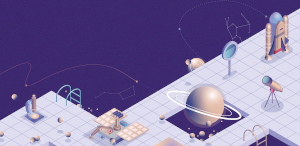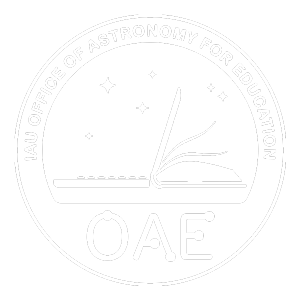This page describes an image Romanian Orion
Image caption:
Winner in the 2022 IAU OAE Astrophotography Contest, category Still images of celestial patterns.
Taken in Romania in August 2012, this image shows two of the most recognisable constellations in the sky, Orion and Taurus.
Orion, the Hunter, is found near the horizon. The most prominent star visible in this image is Betelgeuse, while the asterism of Orion’s belt is formed by three aligned bright stars. Just above Orion we can find Taurus, one of the constellations of the Zodiac. As the Zodiac is inherited from Babylon, The Bull of Heaven represents a mighty but dangerous creature that was defeated by King Gilgamesh and his friend Enkidu. They cut the Bull in half and sacrificed the animal to the gods in order to protect their people. Taurus is also home to the star cluster Pleiades, also known as the Seven Sisters. Two planets are visible: Venus, the bright spot near the fence, and Jupiter, the bright spot at the top, next to the Bull’s face.
Different cultures have included the stars of these constellations in their own mythology. The Romanians, for instance, after Christianisation identified four other constellations using some of the stars of Orion and others surrounding it. One such constellation is called Trisfetitele (the Three Saints), which is associated with the three stars comprising Orion's Belt, representing the Three Hierarchs Basil, Gregory and John. This same asterism is also called Three Wise Men, Kings from the East or just Three Kings — all of these names being rooted in the Christian religion.
The agricultural calendar, in contrast, led farmers to define two other constellations, the Little Plough and the Sickle. Both are seen in the southern half of the Orion rectangle; the Little Plough is drawn by connecting the southern quadrilateral with Orion’s left shoulder, and the Sickle is formed by connecting Orion’s left foot (Rigel) with the belt stars, forming an arch and completing the form of a hoe. In the cultural calendar, these constellations were used to announce the harvest of wheat/grain. Finally, the fourth Romanian constellation is the Great Auger, where Orion’s belt represents the handle of the auger, and Betelgeuse is the tip, facing towards Pollux in Gemini. This constellation is associated with treasure, as Romanian peasants believe that the Auger points to the treasure when they approach the end of the world.
Most of the official star names in Orion are Arabic; Mintaka (meaning “belt”) is at the waist; Alnitak (meaning “girdle”) and Alnilam (meaning “string”) are at the belt; and Rigel (meaning foot) is at the left foot. The star on the left shoulder is named Bellatrix, the Latin term for a female warrior. The star at the right leg is called Saiph, for the sword or sabre of the Arabic Orion.
Scroll to captions in other languages
Image credit:
Alex Conu/IAU OAE
DOI: 10.5281/zenodo.7421682
Related glossary terms:
Asterism
, Constellation
, Gemini
, Jupiter
, Orion
, Pleiades
, Taurus
, Venus
Categories:
Naked Eye Astronomy
Image license: Creative Commons Attribution 4.0 International (CC BY 4.0) Creative Commons Attribution 4.0 International (CC BY 4.0) icons
The media file captions presented on the OAE website were written, translated and reviewed by a collective effort from the OAE, the OAE Centers and Nodes, the OAE National Astronomy Education Coordinators (NAECs) and other volunteers. You can find a full list of credits for our translation project here. All media file captions are released under a Creative Commons CC BY-4.0 license and should be credited to "IAU OAE". The media files themselves may have different licenses (see above) and should be credited as listed above under "credit".
If you notice a factual error in this caption or an error in any of its translations then please get in touch.
Captions in Different Languages:
Image caption: Auszeichnung beim IAU OAE Astrofoto-Wettbewerb 2022, Kategorie Weitwinkelaufnahmen von Himmelsmustern.
Dieses Bild wurde im August 2012 in Rumänien aufgenommen und zeigt zwei der bekanntesten Sternbilder am Himmel: Orion und den Stier (lat. Taurus).
Der Jäger Orion befindet sich in der Nähe des Horizonts. Der auffälligste Stern auf diesem Bild ist Beteigeuze, während die Sterngruppe des Oriongürtels von drei hellen Sternen gebildet wird, die in einer Reihe stehen. Direkt über dem Orion finden wir mit dem Stier eines der Sternbilder des Tierkreises. Da der Tierkreis aus Babylon stammt, steht der Himmelsstier für eine mächtige, aber gefährliche Kreatur, die von König Gilgamesch und seinem Freund Enkidu besiegt wurde. Sie teilten den Stier in zwei Hälften und opferten das Tier den Göttern, um ihr Volk zu schützen. Im Stier befindet sich der Sternhaufen der Plejaden, auch bekannt als die Sieben Schwestern. Zwei Planeten sind ebenfalls zu sehen: Venus, der helle Fleck in der Nähe des Zauns, und Jupiter, der helle Punkt oberhalb der Bildmitte, neben dem Kopf des Stiers.
Verschiedene Kulturen haben die Sterne dieser Sternbilder in ihre eigene Mythologie aufgenommen. In Rumänien zum Beispiel hat man nach der Christianisierung vier weitere Sternbilder aus einigen Sternen des Orion und anderen gebildet, die ihn umgeben. Eines dieser Sternbilder heißt Trisfetitele (die drei Heiligen). Es wird mit den drei Sternen des Oriongürtels in Verbindung gebracht, die die drei Hierarchen Basilius, Gregor und Johannes darstellen. Derselbe Asterismus wird auch Drei Weise Männer, Könige aus dem Osten oder einfach Drei Könige genannt - alle diese Namen haben ihre Wurzeln in der christlichen Religion.
Der landwirtschaftliche Kalender hingegen veranlasste die Bauern, zwei weitere Sternbilder zu definieren: den Kleinen Pflug und die Sichel. Beide sind in der südlichen Hälfte des Orion-Rechtecks zu finden. Für den Kleinen Pflug verbindet man das südliche Viereck mit Orions linker Schulter und die Sichel entsteht aus der Verbindung von Orions linkem Fuß (Rigel) und den Gürtelsternen, wodurch ein Bogen entsteht und die Form einer Hacke vervollständigt wird. Im Kulturkalender wurden diese Sternbilder verwendet, um die Ernte von Weizen/Getreide anzukündigen. Das vierte rumänische Sternbild schließlich ist der Große Erdbohrer, wobei der Gürtel des Orion den Griff des Bohrers darstellt und Beteigeuze die Spitze, die zu Pollux in den Zwillingen zeigt. Dieses Sternbild wird mit Schätzen in Verbindung gebracht, da die rumänischen Bauern glauben, dass der Erdbohrer auf den Schatz zeigt, wenn sie sich dem Ende der Welt nähern.
Die meisten offiziellen Sternnamen im Orion sind arabisch: Mintaka ("Leibriemen") befindet sich an der Taille, Alnitak ("Hüftgürtel") und Alnilam ("Schnur") am Gürtel und Rigel ("Fuß") befindet sich am linken Fuß. Der Stern auf der linken Schulter heißt Bellatrix, die lateinische Bezeichnung für eine Kriegerin. Der Stern am rechten Bein wird Saiph genannt, nach dem Schwert oder Säbel des arabischen Orion.
Image credit: Alex Conu/IAU OAE
Related glossary terms: Asterismus , Jupiter , Orion , Plejaden , Sternbild , Stier , Venus (Planet) , Zwillinge Caption translation status: Not yet approved by a reviewer
Caption translators: Carolin Liefke
Image caption: Vincitore del concorso di astrofotografia IAU OAE 2022, categoria Immagini fisse di modelli celesti.
Scattata in Romania nell'agosto 2012, questa immagine mostra due delle costellazioni più riconoscibili del cielo, Orione e il Toro.
Orione, il Cacciatore, si trova vicino all'orizzonte. La stella più evidente visibile in questa immagine è Betelgeuse, mentre l'asterismo della cintura di Orione è formato da tre stelle luminose allineate. Appena sopra Orione si trova il Toro, una delle costellazioni dello Zodiaco. Poiché lo Zodiaco è ereditato dai babilonesi, il Toro del cielo rappresenta una creatura potente ma pericolosa che fu sconfitta dal re Gilgamesh e dal suo amico Enkidu. Essi tagliarono il Toro a metà e sacrificarono l'animale agli dei per proteggere il loro popolo. Il Toro ospita anche l'ammasso stellare delle Pleiadi, noto anche come le Sette Sorelle. Sono visibili due pianeti: Venere, il punto luminoso vicino al recinto, e Giove, il punto luminoso in alto, accanto al muso del Toro.
Diverse culture hanno inserito le stelle di queste costellazioni nella propria mitologia. I romeni, ad esempio, dopo la cristianizzazione hanno identificato altre quattro costellazioni utilizzando alcune delle stelle di Orione e altre che la circondano. Una di queste costellazioni è chiamata Trisfetitele (i Tre Santi), associata alle tre stelle che compongono la Cintura di Orione e che rappresentano i Tre Gerarchi - Basilio, Gregorio e Giovanni. Questo stesso asterismo è chiamato anche Tre Re Magi, Re dall'Oriente o semplicemente Tre Re, tutti nomi che hanno radici nella religione cristiana.
Il calendario agricolo, invece, ha portato gli agricoltori a definire altre due costellazioni, il Piccolo aratro e la Falce. Entrambe si trovano nella metà meridionale del rettangolo di Orione; il Piccolo Aratro è disegnato collegando il quadrilatero meridionale con la spalla sinistra di Orione, mentre la Falce si forma collegando il piede sinistro di Orione (Rigel) con le stelle della cintura, formando un arco e completando la forma di una zappa. Nel calendario culturale, queste costellazioni venivano utilizzate per annunciare il raccolto del grano. Infine, la quarta costellazione rumena è la Grande Trivella, dove la cintura di Orione rappresenta il manico della trivella e Betelgeuse è la punta, rivolta verso Polluce nei Gemelli. Questa costellazione è associata al tesoro, poiché i contadini rumeni credono che la Trivella indichi il tesoro quando ci si avvicina alla fine del mondo.
La maggior parte dei nomi ufficiali delle stelle in Orione sono arabi; Mintaka (che significa "cintura") si trova all'altezza della vita; Alnitak (che significa "cintura") e Alnilam (che significa "corda") si trovano alla cintura; e Rigel (che significa piede) si trova al piede sinistro. La stella sulla spalla sinistra si chiama Bellatrix, termine latino che indica una donna guerriera. La stella sulla gamba destra è chiamata Saiph, per la spada o sciabola dell'arabo Orione.
Image credit: Alex Conu/IAU OAE
Related glossary terms: Asterismo , Costellazione , Gemelli , Giove , Orione , Pleiadi , Toro , Venere (pianeta) Caption translation status: Approved by a reviewer
Caption translators: Giuliana Giobbi, Francesco Salvestrini
Caption reviewers: Silvia Casu
Image caption: 2022 年国际天文学联合会 OAE 天体摄影比赛静态天体图案类获奖作品。
这幅摄于2012年8月罗马尼亚的影像,定格了夜空中最具辨识度的两大星座——猎户座(Orion)与金牛座(Taurus)的瑰丽身姿。
猎户座(猎人)低悬天际,其最耀眼的恒星参宿四(Betelgeuse,阿拉伯语"巨人腋下")熠熠生辉,三颗明珠串联成著名的"猎户腰带"星群。上方金牛座(黄道星座之一)承袭巴比伦"天之公牛"神话——这头被吉尔伽美什王与恩奇都斩首献祭的神兽,犄角处簇拥着昴星团(Pleiades,七姊妹星团)。影像中可见两大行星:围栏旁的金星(Venus)与牛首上方的木星(Jupiter)。
不同的文化将这些星座的恒星纳入自己的神话中。在罗马尼亚基督教化后的星空解读中,猎户座衍生出四大民间星座。其中"三圣徒"(Trisfetitele)以猎户腰带三星对应巴西尔、格列高利与约翰三位圣徒,该星群亦被称作"东方三博士"或"三王星",折射出深厚的基督教文化烙印。
与此相反,农事历法则孕育出"小耕犁"与"镰刀"星座:前者由猎户四边形南端连至左肩,后者自左足参宿七(Rigel)延伸至腰带三星,构成弧形锄刃,昭示麦收时节。而"寻宝钻"星座(Great Auger)则以腰带为钻柄,参宿四为钻尖指向双子座北河三(Pollux)——民间传说末日临近时,此钻将指引宝藏所在。
猎户众星多承阿拉伯古名:腰际参宿三(Mintaka,意为"腰带")、参宿一(Alnitak,"束带")与参宿二(Alnilam,"珍珠项链")共筑金带;左足参宿七(Rigel,"巨人之足")巍然矗立。左肩"女战士星"(Bellatrix)源自拉丁语,右腿" Saiph"则取自阿拉伯猎户佩剑之名。
Image credit: Alex Conu/IAU OAE
Related glossary terms: 双子座 , 星宿(星群) , 星座 , 昴宿星团 , 木星 , 猎户座 , 金星 , 金牛座 Caption translation status: Not yet approved by a reviewer
Caption translators: Lin Shijie
Image caption: 2022 年國際天文學聯合會 OAE 天體攝影比賽靜態天體圖案類獲獎作品。
這幅攝於2012年8月羅馬尼亞的影像,定格了夜空中最具辨識度的兩大星座——獵戶座(Orion)與金牛座(Taurus)的瑰麗身姿。
獵戶座(獵人)低懸天際,其最耀眼的恆星參宿四(Betelgeuse,阿拉伯語"巨人腋下")熠熠生輝,三顆明珠串聯成著名的"獵戶腰帶"星群。上方金牛座(黃道星座之一)承襲巴比倫"天之公牛"神話——這頭被吉爾伽美什王與恩奇都斬首獻祭的神獸,犄角處簇擁著昴星團(Pleiades,七姊妹星團)。影像中可見兩大行星:圍欄旁的金星(Venus)與牛首上方的木星(Jupiter)。
不同的文化將這些星座的恆星納入自己的神話中。在羅馬尼亞基督教化後的星空解讀中,獵戶座衍生出四大民間星座。其中"三聖徒"(Trisfetitele)以獵戶腰帶三星對應巴西爾、格列高利與約翰三位聖徒,該星群亦被稱作"東方三博士"或"三王星",折射出深厚的基督教文化烙印。
與此相反,農事曆法則孕育出"小耕犁"與"鐮刀"星座:前者由獵戶四邊形南端連至左肩,後者自左足參宿七(Rigel)延伸至腰帶三星,構成弧形鋤刃,昭示麥收時節。而"尋寶鑽"星座(Great Auger)則以腰帶為鑽柄,參宿四為鑽尖指向雙子座北河三(Pollux)——民間傳說末日臨近時,此鑽將指引寶藏所在。
獵戶眾星多承阿拉伯古名:腰際參宿三(Mintaka,意為"腰帶")、參宿一(Alnitak,"束帶")與參宿二(Alnilam,"珍珠項鍊")共築金帶;左足參宿七(Rigel,"巨人之足")巍然矗立。左肩"女戰士星"(Bellatrix)源自拉丁語,右腿" Saiph"則取自阿拉伯獵戶佩劍之名。
Image credit: Alex Conu/IAU OAE
Related glossary terms: 星宿(星群) , 星座 , 昴宿星團 , 木星 , 獵戶座 , 金星 , 金牛座 , 雙子座 Caption translation status: Not yet approved by a reviewer
Caption translators: An automated transliteration from the simplified Chinese translation by - Lin Shijie









